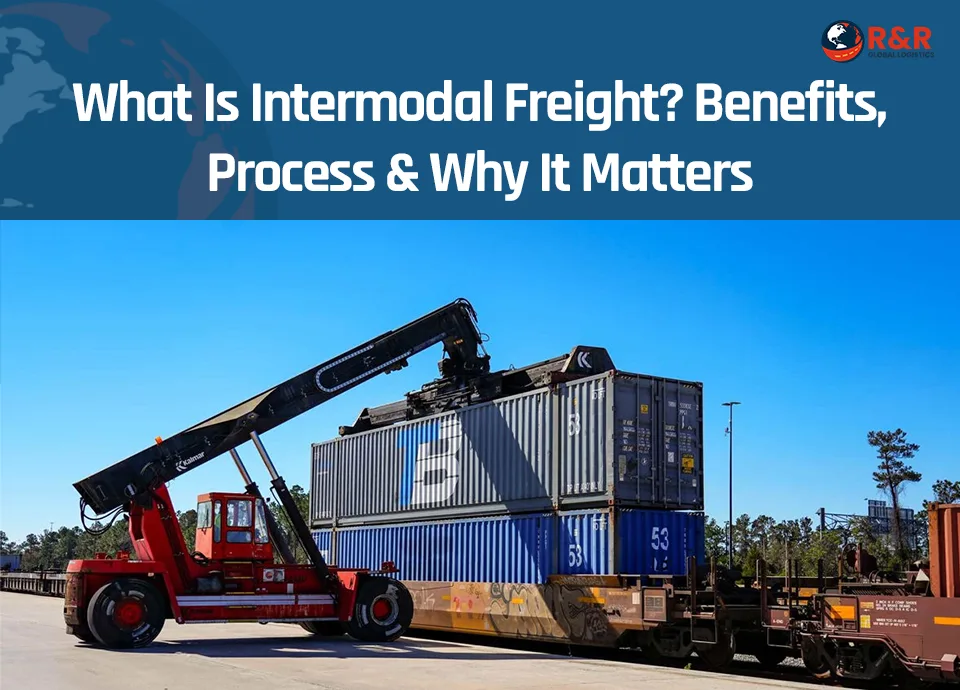Introduction: Meeting Modern Supply Chain Demands
In today’s complex logistics landscape, shippers are constantly looking for ways to move goods faster, reduce costs, and minimize environmental impact. Intermodal freight transportation has emerged as a highly efficient solution, blending multiple modes of transport—typically rail, truck, and sometimes ocean—into a seamless logistics strategy.
In this blog, we’ll explore what intermodal freight is, how it works, its key advantages, and why it’s becoming essential for businesses aiming to scale and optimize their supply chains.
What Is Intermodal Freight?
Intermodal freight is the transportation of goods using two or more different modes of transport—most commonly rail and truck—without handling the freight itself when changing modes. The cargo remains in the same intermodal container throughout its journey.
Unlike multimodal shipping (which may involve separate contracts and handling for each segment), intermodal transport uses standardized containers and coordinated hand-offs between carriers, streamlining operations and reducing cargo handling risks.
Common modes involved:
- Truck (first and final mile)
- Rail (for long-haul domestic transport)
- Ocean (for international shipments)
How Does the Intermodal Freight Process Work?
Intermodal shipping generally follows these steps:
- Pickup by Truck (Drayage): Goods are picked up from the origin point and transported to a rail terminal.
- Rail Transport: The container is loaded onto a rail car for the long-haul portion of the journey.
- Transfer to Destination Terminal: Upon arrival at the receiving rail terminal, the container is offloaded.
- Final Delivery by Truck: A local trucking company (or drayage provider) delivers the container to its final destination.
This end-to-end coordination reduces cost and enhances flexibility—especially for cross-country or high-volume shipments.
Benefits of Intermodal Freight Transportation
1. Cost Savings
Rail is significantly more fuel-efficient than truckload, reducing costs by 10%–40% on long-haul shipments. Shippers benefit from lower fuel surcharges and improved linehaul rates.
2. Scalability
Intermodal transport handles both full truckload (FTL) and less-than-truckload (LTL) volumes, making it ideal for businesses that experience seasonal surges or growth.
3. Reduced Environmental Impact
Moving freight via rail cuts greenhouse gas emissions significantly. A single train can carry the load of 280 trucks and is 3–4 times more fuel efficient.
4. Improved Reliability
Intermodal reduces the risk of road congestion delays and driver shortages. With proper planning, it often results in more consistent transit times.
5. Enhanced Security
Containers remain sealed from origin to destination, reducing theft or tampering during transit.
6. Nationwide Reach
Intermodal connects major cities and ports, making it ideal for port drayage, inland distribution, and cross-border freight.
Why Intermodal Freight Matters for Your Business
In a logistics environment shaped by driver shortages, increased fuel costs, and rising sustainability requirements, intermodal provides a flexible, scalable alternative to traditional trucking.
R&R Global Logistics uses intermodal solutions to help clients:
- Lower transportation costs without sacrificing delivery speed
- Meet sustainability goals with greener freight options
- Manage peak shipping seasons efficiently
- Expand market reach with access to national rail networks
Industries That Benefit from Intermodal Freight
- Retail & E-Commerce: Cost-effective long-haul transport for high-volume shipments
- Manufacturing: Reliable delivery of raw materials and finished goods
- Food & Beverage: Temperature-controlled intermodal for cold chain integrity
- Automotive: Consistent delivery schedules for parts and components
- Agriculture: Bulk commodities moved efficiently across long distances
Is Intermodal Right for You? Questions to Ask
Before choosing intermodal freight, ask:
- Are your origin and destination near rail terminals?
- Are your shipments large or consistent enough for full container loads?
- Is transit time flexibility acceptable for cost savings?
- Are sustainability and emissions reductions important to your brand?
If yes to most, intermodal could be a game-changer for your logistics strategy.
How R&R Global Logistics Delivers Intermodal Success
At R&R Global Logistics, our intermodal freight solutions are fully integrated with our national carrier network. We manage:
- Drayage coordination
- Rail bookings and tracking
- Cross-border logistics
- Temperature-controlled and specialized equipment
- Real-time visibility and exception management
We work with shippers across retail, industrial, food & beverage, and more to streamline their supply chains using smart intermodal planning.
Related Services You Might Find Useful
Conclusion: Intermodal Freight Is the Future of Scalable Logistics
Intermodal freight is more than just a cost-saving option—it’s a sustainable, scalable, and resilient freight strategy. With the right logistics partner, you can transform your supply chain, cut emissions, and improve your bottom line.
Looking to optimize your shipping strategy?
Contact R&R Global Logistics today to explore custom intermodal freight solutions.

